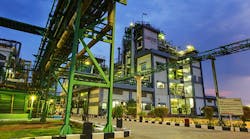Chemical manufacturers have been capturing data from operations for many years. Many of those companies have used the sensor-generated data to improve operational performance through various analytical means. Recent years have seen a lot of developments due to the rise of data science and “lighthouse” projects to prove data analytics can bring organizations to new levels of efficiency, safety and agility.
Developments in “big data” analytics, machine learning and application ease-of-use have spurred increasing interest — and led to two major groups trying to analyze operational performance issues:
• engineers on-site focusing on daily troubleshooting and continuous improvement projects typically using spreadsheets and trend charts, etc.; and
• a central team that includes data scientists handling more-advanced data science modeling.
These groups fundamentally differ in their approach. On-site engineers, who have been trained in the concepts of separation technology, and mass and heat transfer, use their technical knowledge and hands-on experience to address emerging production issues. In contrast, data scientists focus on modeling and interpreting the data generated by the plant.
Bridging The Gap
Now, though, new so-called self-service industrial analytics tools enable the engineers to handle analyses that previously required a data scientist. The tools eliminate the need to develop a data model and, so, allow the engineers to work directly with and in their trend data using pattern recognition technology (Figure 1) in combination with data science techniques and machine learning technology in the back end.
Figure 1. Pattern recognition analyzes performance, finds the root cause of an issue, and enables real-time monitoring of production.
Analytics-empowered engineers themselves can tackle many operational issues such as:
• Solving previously unsolved questions. By using search, filtering, automated pattern recognition and recommendations from the analytics platform, they can find potential root causes of performance drops.
• Testing and verifying the validity of a hypothesis. Often people in operations have a theory about what’s causing certain operational behavior. Using data analytics to assess the soundness of this supposition can eliminate the need for discussions that can consume a lot of time.
• Finding new ways to improve performance. Insights obtained from data can illuminate previously unappreciated opportunities to enhance operations.
• Using actionable dashboards to monitor operational performance in real time. Time-series data can underpin the creation of best-performance operating windows or fingerprints of good behavior. Such dashboards can serve to monitor ongoing operations and alert key stakeholders to take appropriate, proposed action.
• Gaining additional awareness into operational performance. Use of contextual information from third-party business applications, together with other contextual information from other systems, can provide a full operational context to the engineers.
Engineers now can work on more and more difficult use cases. At the same time, the greater efficiency of data scientists’ tools enables them to work on less complex use cases. This gives an overlapping area, where the two groups understand each other better and can start collaborating.
A Corporate Example
Lanxess, Cologne, Germany, is a specialty chemicals company active in 33 countries. It focuses on developing, manufacturing and marketing chemical intermediates, additives, specialty chemicals and plastics. To thrive in this very competitive sector, Lanxess realized it needed to give its production specialists the tools to continuously improve operational performance of their plants.
Lanxess chose to implement self-service industrial analytics software to bring transparency to its production processes and democratize data for all its operations-related employees. The tool now is installed at 75% of Lanxess’ plants worldwide, including all major sites in Europe and North America, with further roll-out continuing. The results have catapulted the company ahead of the competition.
Savings in individual cases have topped six figures, and such wins are multiplying across the group. However, even more importantly, everyone from plant managers to production-line employees now have real-time access to actionable, live production and operational data. That means predictive maintenance and automatic yield calculations, fluid optimization of chemical runs for purity and energy efficiency, and golden-batch detection and analysis.
Jörg Hellwig, chief digital officer of Lanxess, considers digitalization central to the company’s future success. The company established a dedicated service unit in 2017 to push digital business models, introduce new technologies along the entire value chain, and work on the use of big data and the embedding of digital skills among its employees. Hellwig notes that data has empowered production specialists to significantly increase capacity utilization, which cut costs and improved energy efficiency. Moreover, those tools now enable personnel to continuously optimize operational performance across its production plants.
Addressing Roll-Out Challenges
Making analytics-driven decision-making possible at scale in a global organization requires the data to be available, accessible and digestible for the users. Having provided an application to the engineers is no guarantee they will use the new tool. Engineers typically need to see the added value for themselves to become enthusiastic. Lanxess facilitated that transformation by overcoming the following challenges:
1. Proving initial value. When users see the value a new tool can bring, the interest will rise among others to see how they can apply the tool to their own daily operational challenges. Champions were assigned to help these people start using the analytics capabilities themselves.
2. Making self-service analytics available on a global scale. The tool itself was made available to all users. With a modern web-based application, this was easy enough. However, the availability of the data of all the production facilities in a harmonized configuration and nomenclature was crucial for knowledge exchange and speeding up the learning curve.
3. Changing behavior/perception of production data on the plant level. Some users are more receptive to change than others. Therefore, common change-management tactics were applied to help change the behavior of the users.
4. Taking common decisions on a global level. Although democratizing analytics means everybody can use the software, some decisions still must be made centrally, requiring upper management support for the central team.
The digitalization business unit of Lanxess realized a successful roll-out demanded several key steps.
The first was the creation of a central project with a dedicated roll-out team within the business unit. This roll-out team consisted of operations technology specialists with engineering and production data analytics expertise and with some information technology background.
Second was the adding of project personnel to the team responsible for digitalization projects within Lanxess, to complement its engineering and production data analytics expertise. These experts helped the local plants and users become successful with the new tool by setting up the roll-out structure and determining the roles and responsibilities of the team. At each site, the roll-out team started with a kickoff meeting to set the goals and expectations, select the key stakeholder for the plant, and plan on-site training.
To inspire the users to change their behavior, Lanxess took a third step: the creation of individual success plans in cooperation with the business units the people were working for, with clear roles and resource commitments. The people could fall back on a global process and asset analytics community to exchange ideas and best practices. The individual success plans were determined in line with the yearly reward per working group. The person or team with the best solved use cases was entitled to present those achievements at the global management meeting.
The last step was the creation of a digital working group for production that acts as a steering committee, with stakeholders from business-unit production management. Members include the plant manager, a plant engineer and foreman or, optionally, a shift foreman and at least one operator (ideally, one per shift or more). The steering committee gets a bimonthly status report on progress and holds a biweekly operational meeting with the local working group focusing on best practices and best use cases to leverage at other sites, too.
A Resounding Success
Lanxess today has converted over 75% of its production facilities to use industrial analytics and enable its operational experts to make analytics-driven decisions that can increase its capacity and lower costs at the same time. The company has significantly raised its capacity utilization in selected plants, optimized resource efficiency and reduced maintenance costs with the help of industrial analytics. In some cases, this has resulted in savings amounting to hundreds of thousands of euros. Further benefits should accrue through the structural business unit enablement and support by the central and local champions.
EDWIN VAN DIJK is vice president of marketing for TrendMiner, Hasselt, Belgium. Email him at [email protected].


